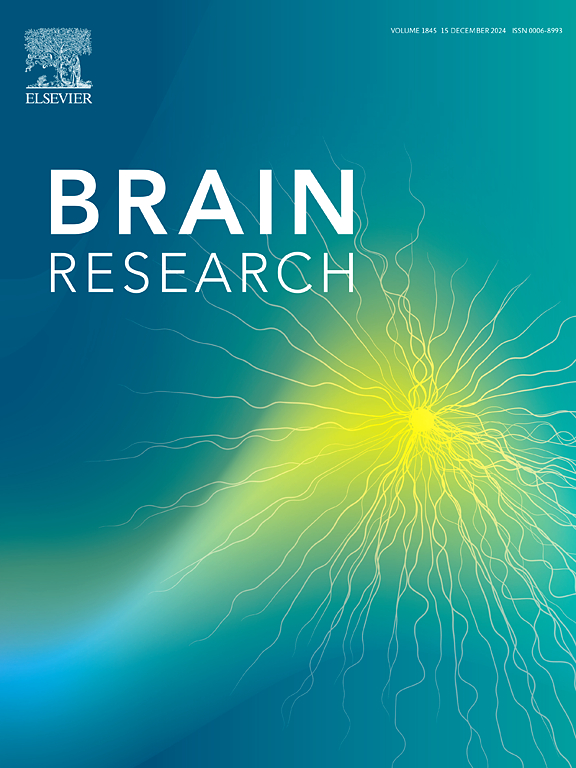Dynamic analysis of frequency specificity in multilayer brain networks
IF 2.6
4区 医学
Q3 NEUROSCIENCES
引用次数: 0
Abstract
The brain is a highly complex and delicate system, and its internal neural processes are manifested as the interweaving and superposition of multi-frequency neural signals. However, traditional brain network studies are often limited to the whole frequency band or a specific frequency band, ignoring the potentially profound impact of the diversity of information within the frequency on the dynamics of brain networks. To comprehensively and deeply analyze this phenomenon, the present study is devoted to exploring the specific performance of brain networks at different frequencies. We used the maximum overlap discrete wavelet transform technique to finely divide the time series data into the following frequency bands: scale 1 (0.125–0.25 Hz), scale 2 (0.06–0.125 Hz), scale 3 (0.03–0.06 Hz) and scale 4 (0.015–0.03 Hz). Based on these frequency bands, we constructed multilayer networks from both dynamic and static perspectives, respectively. From the dynamic perspective, we quantitatively evaluated the dynamic differences among different frequency bands using metrics such as flexibility, promiscuity, integration, and recruitment, and found that scale 3 and scale 4 bands performed particularly well. In contrast, from a static perspective, we measured the cross-frequency interaction capability between different frequency bands through metrics such as multilayer clustering coefficient and entropy of multiplexing degree, and the results show that scale 2, scale 3, and scale 4 band networks have enhanced global integration capability and local capability. In addition, we explored the correlation of gender and age with the properties of brain networks in different frequency bands. In the scale 1 frequency band, the organization of brain functions showed significant gender differences, while in the scale 2 frequency band, there was a significant correlation between age and global efficiency. By integrating the dual perspectives of time and frequency domains, this study not only reveals the critical role of frequency specificity in the brain’s information processing and functional organization but also provides new perspectives for understanding the complex working mechanisms of the brain as well as gender- and age-related cognitive differences.

多层脑网络频率特异性的动态分析。
大脑是一个高度复杂和精细的系统,其内部的神经过程表现为多频神经信号的交织和叠加。然而,传统的脑网络研究往往局限于整个频段或特定频段,忽视了频率内信息多样性对脑网络动态的潜在深远影响。为了全面深入地分析这一现象,本研究致力于探索不同频率下大脑网络的具体性能。我们使用最大重叠离散小波变换技术将时间序列数据精细划分为以下频段:尺度1(0.125-0.25 Hz)、尺度2(0.06-0.125 Hz)、尺度3(0.03-0.06 Hz)和尺度4(0.015-0.03 Hz)。基于这些频带,我们分别从动态和静态两个角度构建了多层网络。从动态角度来看,我们使用灵活性、滥交、整合和招聘等指标定量评估了不同频段之间的动态差异,发现规模3和规模4频段表现特别好。在静态视角下,通过多层聚类系数、复用度熵等指标衡量不同频段间的交叉交互能力,结果表明,规模2、规模3、规模4频段网络的整体集成能力和局部集成能力均有所增强。此外,我们还探讨了性别和年龄与不同频段大脑网络特性的相关性。在量表1频带中,脑功能的组织存在显著的性别差异,而在量表2频带中,年龄与整体效率之间存在显著的相关性。本研究通过整合时间域和频域的双重视角,不仅揭示了频率特异性在大脑信息处理和功能组织中的重要作用,而且为理解大脑复杂的工作机制以及与性别和年龄相关的认知差异提供了新的视角。
本文章由计算机程序翻译,如有差异,请以英文原文为准。
求助全文
约1分钟内获得全文
求助全文
来源期刊

Brain Research
医学-神经科学
CiteScore
5.90
自引率
3.40%
发文量
268
审稿时长
47 days
期刊介绍:
An international multidisciplinary journal devoted to fundamental research in the brain sciences.
Brain Research publishes papers reporting interdisciplinary investigations of nervous system structure and function that are of general interest to the international community of neuroscientists. As is evident from the journals name, its scope is broad, ranging from cellular and molecular studies through systems neuroscience, cognition and disease. Invited reviews are also published; suggestions for and inquiries about potential reviews are welcomed.
With the appearance of the final issue of the 2011 subscription, Vol. 67/1-2 (24 June 2011), Brain Research Reviews has ceased publication as a distinct journal separate from Brain Research. Review articles accepted for Brain Research are now published in that journal.
 求助内容:
求助内容: 应助结果提醒方式:
应助结果提醒方式:


